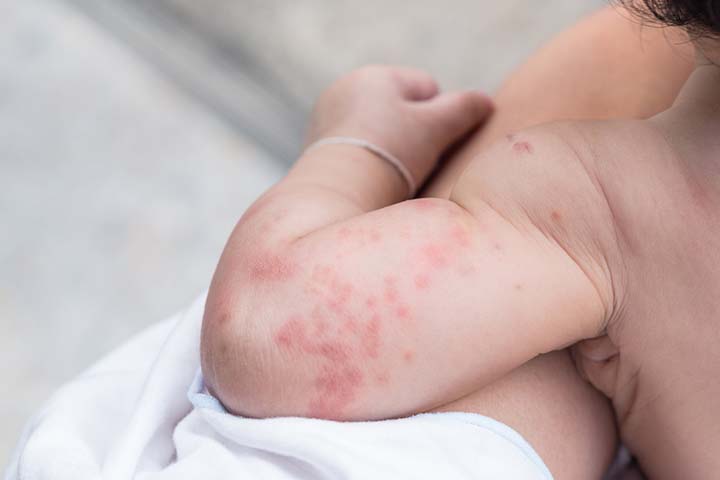When transitioning your baby from breast milk to their first solid feeding, you must be cautious about the food you give them. If you are considering introducing them to cereals such as wheat, you should be aware of the symptoms of wheat allergy in babies to detect any reactions and stop feeding it at the earliest.
Wheat is a good source of carbohydrates, and its fiber content enables healthy digestion (1 ). It also contains several minerals and is thus a healthy nutritional source for babies (2).
Read this post to learn more about the causes of wheat allergy in babies, the most common symptoms, and how to manage wheat allergy in infants.
What Is Wheat Allergy In Babies?
Wheat allergy is caused by an immune response triggered by food sensitivities. This happens when your baby’s immune system is exposed to any one of the four proteins present in wheat, such as albuminiXA protein synthesized in the liver, essential to prevent fluid from leaking out of the blood vessels into other tissues., gluten, globulin, or gliadiniXProteins present in rye, wheat, and barley. (3):
- Your baby’s body would misinterprets that these proteins are a threat to the baby’s health.
- As a result, your baby’s antibodies would fight against it.
If you are feeding your baby wheat for the first time and it causes your baby to vomit, develop skin rashes, or have other stomach-related issues, it indicates that your baby is allergic to wheat.
4 Symptoms Of Wheat Allergy In Babies
Wheat allergy can trigger an array of symptoms related to your baby’s respiratory system, brain, digestive system, skin, etc. Keep an eye over your baby after feeding her foods made from wheat.
Here are some of the most common signs of wheat allergy in a baby:
1. Reddish Raised Spots:
This symptom caused by wheat allergy is also known as hives (4).
- Your baby may get reddish and raised spots that are itchy. These should subside in a couple of hours.
- Hives would appear on various parts of the baby such as hands, face, arms, chest, and stomach, soon after consuming wheat.
- If your baby has a severe allergy to wheat, they would develop this symptom almost immediately.
- This reaction may worsen with the second exposure as antibodiesiXProteins in the body that protects from a foreign substance entering the system. against this protein start to form.
2. Eczema Skin Condition:
An allergic reaction to wheat in a baby can cause or worsen the skin condition known as eczema. This can happen in various parts of your baby’s body, such as the neck, face, mouth, cheeks, behind the ears, and legs, soon after you feed her with a formula or food items containing wheat. It can appear as (5):
- Dry patches on the skin.
- Reddish spots and itchy skin.
- Swollen and crusty appearance.
- Inflammation and oozing of fluid.
3. Symptoms Related To Digestive System:
Wheat allergy can cause various symptoms associated with digestive symptoms and intestines. These symptoms tend to surface within two hours of feeding your baby wheat-based foods (5):
- Digestive symptoms such as nausea, bloating, vomiting, diarrhea, indigestion, and gas.
- These symptoms would accompany cold feet condition in your baby.
- Abdominal pain would make your baby cry uncontrollably by clenching the wrists and flexing her legs.
4. Symptoms Related To Breathing Issues:
Your baby would experience various symptoms related to breathing as the wheat allergens would irritate the immune system. These can have symptoms like (4):
- Wheezing
- Breathing noisily
- Nasal congestion
- Runny nose
- Inflammation in lungs, nose, and throat
- Asthmatic allergies
- Anaphylactic shockiXReaction characterized by a drop in blood pressure, swelling of vessels that carry air, wheezing, shortness of breath, and loss of consciousness. in severe cases
- Inflamed throat and coughing
- Difficulty to breathe
- Difficulty in swallowing
If you notice any one or more of these wheat allergy symptoms in babies, it is essential to seek the advice of your pediatrician immediately.
Tackling Wheat Allergy:
As soon as you find that your baby has developed an allergy to wheat within 2 to 3 hours of consumption, you need to seek the advice of your doctor (6).
If your baby’s symptoms are severe then your doctor would advise you to take up a skin prick test or blood tests.
-
- Watch how many days it takes for the symptoms of wheat allergy to resolve.
- Maintain a food journal to know which foods trigger an allergy in your baby.
- Make sure you eliminate all those foods that contain wheat from your baby’s diet.
- When you are shopping for groceries, eliminate all those foods that have gluten or wheat-based ingredients by reading the label at the back of the products. Take this precautionary measure as your child might have gluten intolerance.
- Some babies would outgrow food allergies when they reach the age of 3. According to the American College of Allergy, Asthma, and Immunology, approximately 65% of children diagnosed with a wheat allergy will outgrow it by 12. So ensure you seek the advice of an allergist to test your baby periodically to determine whether wheat can be a part of their diet.
Wheat is a good carbohydrate source and contains essential nutrients. You may want to introduce it to your babies when they start eating solid foods. However, you should be cautious, as wheat contains four types of proteins that may cause allergic reactions in some children. If you notice symptoms of wheat allergy in babies, such as reddish raised spots, eczema, or digestive issues, you should consult a doctor. Also, keep a food diary to account for the foods that trigger allergies. Avoid foods with gluten or wheat. Some babies may outgrow the allergy with time. So seek an allergist’s opinion on this issue.
Key Pointers
- The main symptoms of wheat allergy are hives, diarrhea, vomiting, and breathing problems.
- Wheat allergy can lead to anaphylaxis, a severe allergic reaction.
- Diagnosis of wheat allergy can be confirmed through skin prick tests, blood tests, and food elimination for tracking symptoms.
- The simplest way to manage a wheat allergy is to avoid wheat and products that contain wheat.
- It is crucial for parents to read food labels carefully to avoid gluten or wheat-based ingredients.
If your baby possesses a wheat allergy you may wonder how to deal with it. Watch this video to learn about the signs and symptoms of such an allergy and how they can be managed.













